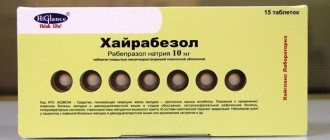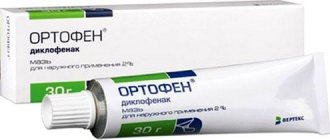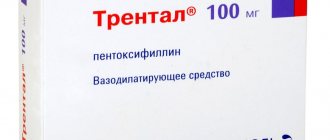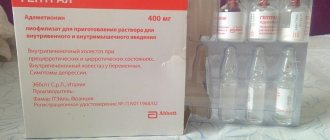pharmachologic effect
A drug that reduces the secretion of gastric glands - a proton pump inhibitor.
Esomeprazole is the S-isomer of omeprazole and reduces gastric acid secretion by specifically inhibiting the proton pump in gastric parietal cells. The S- and R-isomers of omeprazole have similar pharmacodynamic activities.
Esomeprazole is a weak base that transforms into an active form in the highly acidic environment of the secretory tubules of the parietal cells of the gastric mucosa and inhibits the proton pump - the enzyme H / K -ATPase, thereby inhibiting both basal and stimulated secretion of hydrochloric acid.
Effect on the secretion of hydrochloric acid in the stomach
After oral administration of 20 mg or 40 mg, the effect of esomeprazole develops within 1 hour. When taking the drug daily for 5 days at a dose of 20 mg once a day, the average maximum concentration of hydrochloric acid after stimulation with pentagastrin is reduced by 90% (when measuring the acid concentration 6-7 hours after taking the drug on the 5th day of therapy).
In patients with gastroesophageal reflux disease (GERD) and the presence of clinical symptoms, after 5 days of daily oral esomeprazole 20 mg or 40 mg, intragastric pH values above 4.0 were maintained for an average of 13 and 17 hours out of 24 hours. When taking esomeprazole at a dose of 20 mg per day, intragastric pH above 4.0 was maintained for at least 8, 12 and 16 hours in 76%, 54% and 24% of patients, respectively.
A correlation was identified between the concentration of the drug in plasma and the inhibition of hydrochloric acid secretion (to assess the concentration, the AUC parameter was used - the area under the concentration-time curve).
The therapeutic effect achieved by inhibiting the secretion of hydrochloric acid
When taking the drug at a dose of 40 mg, healing of reflux esophagitis occurs in approximately 78% of patients after 4 weeks of therapy and in 93% of patients after 8 weeks of therapy.
Treatment with esomeprazole 20 mg twice daily in combination with appropriate antibiotics for one week results in successful eradication of Helicobacter pylori in approximately 90% of patients.
Patients with uncomplicated peptic ulcer disease after a week-long eradication course do not require subsequent monotherapy with drugs that reduce the secretion of gastric glands to treat the ulcer and eliminate symptoms.
The effectiveness of esomeprazole in bleeding from peptic ulcers, confirmed endoscopically, has been shown.
Esomeprazole
Esomeprazole
(eng.
esomeprazole
) - an antiulcer drug, a proton pump inhibitor (PPI).
Chemical compound:
(S)-5-Methoxy-2-[[(4-methoxy-3,5-dimethyl-2-pyridinyl)methyl]sulfinyl]-3H-benzimidazole. The empirical formula is C17H19N3O3S.
Esomeprazole is the international nonproprietary name (INN) of the drug. According to the pharmacological index, it belongs to the group “Proton pump inhibitors”. According to ATC, it belongs to the group “Proton pump inhibitors” and has the code A02BC05.
Indications for use of esomeprazole
Gastroesophageal reflux disease (GERD): erosive reflux esophagitis (treatment), prevention of relapses in patients with cured esophagitis, symptomatic treatment of GERD. As part of combination therapy: eradication of Helicobacter pylori, duodenal ulcer associated with Helicobacter pylori, prevention of relapse of ulcers in patients with gastric and duodenal ulcer associated with Helicobacter pylori.
Doses and order of taking esomeprazole
The esomeprazole tablet should be swallowed whole with liquid.
Tablets must not be chewed or broken. For patients who have problems swallowing, esomeprazole tablets are dissolved in still water and the solution is administered through a nasogastric tube. Treatment of erosive reflux esophagitis:
40 mg 1 time per day for four weeks. An additional 4-week course of treatment is recommended in cases where, after the first course, esophagitis is not cured or symptoms persist. Prevention of relapses in patients with cured esophagitis: 20 mg 1 time per day.
Symptomatic treatment of GERD:
20 mg 1 time per day - for patients without esophagitis. If symptoms do not disappear after 4 weeks of treatment, the patient should be further examined.
Treatment of duodenal ulcer associated with Helicobacter pylori,
prevention of relapse
of peptic ulcers in patients with peptic ulcers associated with Helicobacter pylori:
esomeprazole - 20 mg, amoxicillin - 1 g and clarithromycin - 500 mg 2 times a day for 7 days.
For patients with renal failure and for elderly patients, no dose adjustment is required. In case of severe liver failure, the daily dose of esomeprazole should not exceed 20 mg.
Long-term or high-dose use of esomeprazole increases the risk of hip, wrist, and spine fractures (“FDA Warning”).
Comparison of esomeprazole with other proton pump inhibitors
Among gastroenterologists, there are two opposing points of view on esomeprazole.
Some of them believe that esomeprazole is fundamentally different from the other four PPIs: omeprazole, pantoprazole, lansoprazole and rabeprazole (Lapina T.L., Demyanenko D., etc.), others - that, despite some differences that exist between PPIs, Today there is no evidence that one of the PPIs is noticeably more effective than others in the treatment of acid-related diseases (Vasiliev Yu.V. et al.) or as part of triple (quadruple) therapy in the eradication of HP (Nikonov E.K.). According to Bordin D.S., the effectiveness of all PPIs for long-term treatment of GERD is similar. In the early stages of therapy, lansoprazole has some advantages in the speed of onset of effect, which potentially increases patient adherence to treatment. If you need to take several drugs to simultaneously treat other diseases, pantoprazole is the safest.
Stereoisomers are substances whose molecules have the same composition and the same sequence of chemical bonds of atoms, but their different locations relative to each other in space. Stereoisomers that are mirror images of each other are called optical isomers. Pairs of optical isomers are designated as R (from the Latin rectus
- right) and S (from Latin
sinister
- left). Such isomers can vary significantly in biological activity.
All PPIs, with the exception of esomeprazole (and dexlansoprazole, which is not registered in Russia), are racemates, that is, a mixture of R- and S-isomers. Esomeprazole is the S-isomer of omeprazole. The mechanism of action of esomeprazole is inhibition of the proton pump and, as a consequence, a decrease in the secretion of hydrochloric acid by parietal cells, and does not differ from other PPIs. The main difference is that when PPIs further enter the bloodstream into the liver, the different isomers are metabilized differently. If during the first passage of the liver 98% of the R-isomer is excreted, then for the S-isomer (esomeprazole) this figure is significantly less - 73%. Therefore, most of the drug remains in the body and a more effective acid-suppressing effect of the drug is ensured (Lapina T.L.).
The pharmacokinetics of esomeprazole are less subject to individual fluctuations compared to the pharmacokinetics of omeprazole. This indicates a reduction in interindividual variability in acid control and, therefore, an increase in clinical predictability and reliability of pharmacotherapy using esomeprazole. Due to improved pharmacokinetics, the antisecretory effect of esomeprazole is more pronounced, faster to manifest and more stable compared to that of omeprazole. When performing daily pH measurements
against the background of oral administration of 40 mg of esomeprazole or omeprazole after 12 hours, the proportion of patients with intragastric pH > 4 was 88 and 75%, respectively, and after 24 hours the proportion of patients with intragastric pH > 4 was 68.4% of all those receiving esomeprazole and 62.0 % of all those receiving omeprazole. A comparative analysis of the pharmacodynamic parameters of oral forms of esomeprazole 40 mg, pantoprazole 40 mg, rabeprazole 20 mg allowed us to conclude that esomeprazole has a fundamentally better efficacy profile. Daily pH measurements against the background of oral administration of drugs revealed that on the 5th day the proportion of patients with intragastric pH > 4 was 69.8% in the esomeprazole group, 44.8% in the pantoprazole group and 44.5 in the rabeprazole group. % (Golovin R.A. et al.).
According to some researchers, rabeprazole has a shorter latency period and a longer duration of antisecretory effect than esomeprazole, as well as a lower frequency of side effects (Yastrebkova L.A.).
However, the cost of a comparable dose of esomeprazole is significantly higher than that of omeprazole. At the same time, there are studies showing that treatment of GERD with esomeprazole is more cost-effective than rabeprazole (Rudakova A.V.).
Report by V.O. Kaibysheva at the conference “Esophagus-2014”. 40 mg of esomeprazole twice a day provides the necessary decrease in acidity in the stomach and the absence of acid reflux in the esophagus in patient O., 23 years old with multiple erosions of the esophagus, with complaints of heartburn, night heartburn, sour belching
Publications for healthcare professionals regarding the use of esomeprazole in the treatment of gastrointestinal diseases
- Lapina T.L. Esomeprazole - the first proton pump blocker - monoisomer: new prospects in the treatment of acid-dependent diseases // Clinical pharmacology and therapy. - 2002. - Volume 11. - No. 2.
- Ivashkin V.T., Nemytin Yu.V., Makarov Yu.S. et al. Comparative assessment of the antisecretory activity of Losec MAPS, Pariet and Nexium in patients with peptic ulcer. TsVKG im. A.A. Vishnevsky, MMA named after. THEM. Sechenov.
- Abdulkhakov R.A. Evaluation of the antisecretory effect of esomeprazole (Nexium, Astrazeneka) in patients with peptic ulcer disease based on the results of daily pH-metry // Experimental and clinical gastroenterology. - 2003. - No. 1.
- Lapina T.L. Proton pump inhibitors: from pharmacological properties to clinical practice // Pharmateka. – 2002. – No. 9. – p. 3–8.
- Morozov S.V., Tsodikova O.M., Isakov V.A. and others. Comparative effectiveness of the antisecretory action of rabeprazole and esomeprazole in individuals who rapidly metabolize proton pump inhibitors // Experimental and clinical gastroenterology. – 2003. – No. 6.
- Yastrebkova L.A. Comparative clinical effectiveness and safety of rabeprazole (Pariet) and esomeprazole (Nexium) in the treatment of acid-related diseases of the gastrointestinal tract // MEDGAZETA. 07/08/2009.
- Blakhov N.Yu., Patsay D.I. The effectiveness of omeprazole and esomeprazole in the prevention of stress damage to the gastrointestinal tract in patients with acute pancreatitis // Belarusian-Polish Days of Surgery: collection. mat. VI Int. scientific-practical symposium. 2013. pp. 157–159.
- Bordin D.S., Berezina O.I., Yanova O.B., Kim V.A. The effectiveness of esomeprazole in the treatment of gastroesophageal reflux disease // Gastroenterology. 2015. No. 2. pp. 20–25.
- Kurilovich S.A., Chekalina E.A., Belkovets A.V., Shcherbakova L.V. Dose-dependent antisecretory activity of esomeprazole: results of long-term monitoring of intragastric pH // RZHGGK. – 2021. – No. 3. pp. 33-40.
- Yurenev G.L., Partsvania-Vinogradova E.V. and others. Possibilities of the S-enantiomer of the classical molecule omeprazole (esomeprazole) in the treatment of gastroesophageal reflux disease // Consilium medicum. – 2021. – No. 8. – Volume 18. pp. 27-31.
On the website
GastroScan.ru in the Literature section there is a subsection “
Esomeprazole
”, containing publications for healthcare professionals that address the treatment of digestive diseases with esomeprazole.
Videos (reports and lectures) for healthcare professionals covering the use of esomeprazole
| Abdulkhakov S.R. Modern approach to the treatment of acid-related diseases: which therapy to choose? | |
| Galeeva Z.M. Extraesophageal manifestations of GERD. Clinical case | |
| Zyryanov S.K. Off-label PPI prescription: causes and consequences |
On the website in the “Video” section there is a subsection “Reports and Lectures”, containing video recordings of reports, lectures, webinars in various areas of gastroenterology for healthcare professionals.
Pharmacokinetics of esomeprazole
Esomeprazole is unstable in an acidic environment. In the body, only a small part of esomeprazole is converted into the R-isomer. Quickly absorbed. TCmax - 1-2 hours. Absolute bioavailability after repeated dosing of 20 mg of esomeprazole once daily is 89%. Volume of distribution - 0.22 l/kg. Communication with plasma proteins - 97%. Completely metabolized with the participation of the cytochrome P450 system. The main part is metabolized with the participation of cytochrome CYP2C19, resulting in the formation of hydroxy and demethylated metabolites of esomeprazole. Metabolism of the remaining part is carried out by another enzyme - CYP3A4; this produces a sulfo derivative of esomeprazole, which is the main metabolite detected in plasma. All metabolites are pharmacologically inactive. In patients with active CYP2C19 (patients with active metabolism), systemic clearance is 17 l/h after a single dose and 9 l/h after multiple doses. T½ – 1.3 hours when taken systematically in a dosing regimen of 1 time per day. AUC increases with repeated dosing (non-linear relationship between dose and AUC during systemic administration, which is a consequence of decreased first-pass metabolism, as well as decreased systemic clearance caused by inhibition of the CYP2C19 enzyme by esomeprazole and/or its sulfonic metabolite). Does not accumulate. Up to 80% of the dose is excreted in the form of metabolites by the kidneys (less than 1% unchanged), the rest is excreted in bile. In poor metabolizers (1-2%), esomeprazole is metabolized primarily by CYP3A4. When systematically taking 40 mg of esomeprazole 1 time per day, the average AUC is 100% higher than the value of this parameter in patients with active metabolism. Mean plasma Cmax values in patients with inactive metabolism are increased by approximately 60%. In patients over 70 years of age, the metabolism of esomeprazole does not undergo significant changes. The metabolism of esomeprazole in patients with mild or moderate hepatic impairment is similar to that in patients with normal liver function. In severe liver failure, the metabolic rate is reduced, which is accompanied by a 2-fold increase in AUC. The metabolism of esomeprazole does not change in patients with renal failure.
Pharmacodynamics of esomeprazole
Esomeprazole is the dextrorotatory isomer of omeprazole.
It, like other PPIs, reduces the secretion of hydrochloric acid in the stomach by inhibiting the proton pump in the parietal cells of the gastric mucosa. Transforming into an active form in the acidic environment of the secretory tubules of parietal cells, esomeprazole is activated and inhibits the proton pump, inhibiting the secretion of hydrochloric acid. The effect of esomeprazole occurs within an hour after taking 20 mg or 40 mg orally. When taking esomeprazole for five days at a dose of 20 mg once a day, the average maximum concentration of hydrochloric acid after stimulation with pentagastrin is reduced by 90%. When taking esomeprazole at a dose of 40 mg, cure of reflux esophagitis occurs in approximately 78% of patients after 4 weeks of therapy and in 93% after 8 weeks. Treatment with esomeprazole at a dose of 20 mg 2 times a day in combination with standard antibacterial drugs for a week leads to successful eradication of Helicobacter pylori in approximately 90% of patients. Patients with an uncomplicated duodenal ulcer after a week-long course of eradication to heal the ulcer and eliminate symptoms do not need to continue taking antisecretory drugs.
Interaction of esomeprazole with other drugs
Esomeprazole reduces the absorption of ketoconazole and itraconazole.
Esomeprazole inhibits CYP2C19 and CYP3A4, therefore, the combined use of esomeprazole with other drugs in which CYP2C19 is involved in the metabolism (diazepam, citalopram, imipramine, clomipramine, phenytoin and others) may lead to an increase in their plasma concentrations and require a dose reduction. When 30 mg of esomeprazole and diazepam are taken together, the clearance of the enzyme-substrate complex (CUR2C19-diazepam) is reduced by 45%. Minimum concentrations of phenytoin in the plasma of patients with epilepsy increased by 13% when combined with 40 mg of esomeprazole. In this regard, it is recommended to monitor plasma concentrations of phenytoin when starting treatment with esomeprazole and when discontinuing it. In healthy volunteers, co-administration of cisapride with 40 mg of esomeprazole led to an increase in the pharmacokinetic parameters of cisapride: AUC by 32% and T½ by 31%, but plasma concentrations of cisapride did not change significantly. With this combination, the effect of cisapride on cardiac electrophysiological parameters did not change. Esomeprazole does not cause clinically significant changes in the pharmacokinetics of amoxicillin, quinidine and warfarin. Co-administration of esomeprazole with clarithromycin (500 mg 2 times a day), which inhibits CYP3A4, leads to a 2-fold increase in the AUC of esomeprazole. No dose adjustment of esomeprazole is required in this case. If it is necessary to take proton pump inhibitors and clopidogrel simultaneously, the American Heart Association recommends taking pantoprazole instead of esomeprazole (Bordin D.S.).
Use of esomeprazole during pregnancy and breastfeeding
Taking esomeprazole to treat GERD during the first trimester of pregnancy more than doubles the risk of having a baby with heart defects (GI & Hepatology News, August 2010).
The FDA Fetal Risk Category for use of esomeprazole in pregnant women is C (animal studies have shown adverse effects of the drug on the fetus, and there have been no adequate studies in pregnant women, but the potential benefits associated with the use of this drug in pregnant women may justify its use, despite at the existing risk). During treatment with esomeprazole, breastfeeding should be stopped.
Instructions for medical use of certain esomeprazole drugs
- Instructions for medical use of the drug Emanera (enteric capsules, 20 and 40 mg), approved by the Ministry of Health of Russia on 10/12/17 (pdf)
- Instructions for the medical use of the drug Esomeprazole-native (lyophilisate for the preparation of a solution for intravenous administration), approved by the Ministry of Health of Russia on 04/05/17 (pdf)
- Instructions (medical guide) for US patients (in English, pdf): “Medication Guide Nexium (esomeprazole magnesium) Delayed-Release Capsules, Nexium (esomeprazole magnesium) for Delayed-Release Oral Suspension.”
Esomeprazole and driving
The effect of esomeprazole on the ability to drive vehicles and operate machinery
has not been identified.
Medicines containing the active ingredient esomeprazole
The following drugs with the active substance esomeprazole are registered in Russia - Nexium, Neo-Zext, Esomeprazole-Vial, Esomeprazole Zentiva, Esomeprazole Canon, Esomeprazole-native, Emanera, Emezol.
In some countries, drugs with the active substance esomeprazole are registered: Nexium, NexIUM OTC, Nexium 24HR and Nexium IV (USA), Esopral (Italy, the Netherlands), Axagon (Italy), Nexiam (Belgium, Luxembourg, South Africa), generics of esomeprazole: Sompraz ( India, Myanmar), Neksium and Neksium Inj (India), Nexpro (India), Ezokar (Belarus, Palestine). Gelacid 40 is registered in Uzbekistan (in some other countries it is sold under the name Nexum, manufactured by Square, Bangladesh). In the USA (in 2014), over-the-counter esomeprazole (Nexium 24HR, extended-release capsules containing 20 mg esomeprazole) was approved for use on March 28, 2014, in the European Union - on August 26, 2013.
In 2012, the drug Vimovo with the combined active ingredient esomeprazole + naproxen
, intended for the symptomatic treatment of osteoarthritis, rheumatoid arthritis and ankylosing spondylitis (a similar drug Vimovo is approved for use in the USA and EU).
Esomeprazole has contraindications, side effects and application features; consultation with a specialist is necessary.
Back to section
Indications for use
- Gastroesophageal reflux disease (GERD)
- Treatment of erosive reflux esophagitis: Long-term maintenance treatment after healing of erosive reflux esophagitis, prevention of relapses;
- Symptomatic treatment of GERD.
- Treatment of duodenal ulcer associated with Helicobacter pylori;
- Treatment of stomach ulcers caused by taking NSAIDs;
Directions for use and doses
Inside. The tablet should be swallowed whole, without chewing, with a sufficient amount of water.
- Adults and children from 12 years old
- Gastroesophageal reflux disease
Treatment of erosive reflux esophagitis: 40 mg once a day for 4 weeks.
An additional 4-week course of treatment is recommended in cases where, after the first course, healing of esophagitis does not occur or symptoms persist.
Long-term maintenance treatment after healing of erosive reflux esophagitis, prevention of relapses: 20 mg once a day.
Symptomatic treatment of GERD: 20 mg once daily in patients without esophagitis. If symptoms do not disappear after 4 weeks of treatment, the patient should be further examined. After symptoms have resolved, you can switch to an “as needed” regimen of 20 mg once daily when symptoms return. For patients taking NSAIDs who are at risk of developing gastric or duodenal ulcers, treatment on an as-needed basis is not recommended.
- Adults
- Peptic ulcer of the stomach and duodenum
As part of combination therapy for Helicobacter pylori eradication:
- treatment of duodenal ulcer associated with Helicobacter pylori: the drug Esomeprazole Canon 20 mg, amoxicillin 1000 mg and clarithromycin 500 mg. All medications are taken 2 times a day for 1 week.
- prevention of relapses of peptic ulcers associated with Helicobacter pylori: the drug Esomeprazole Canon 20 mg, amoxicillin 1000 mg and clarithromycin 500 mg. All medications are taken 2 times a day for 1 week.
Long-term acid suppression therapy in patients who have suffered bleeding from a peptic ulcer (after intravenous use of drugs that reduce the secretion of gastric glands to prevent relapse): Esomeprazole Canon 40 mg 1 time per day for 4 weeks after intravenous use of drugs that reduce the secretion of gastric glands.
- Patients taking NSAIDs for a long time
Treatment of stomach ulcers caused by taking NSAIDs: Esomeprazole Canon 20 mg once a day; Duration of treatment is 4-8 weeks.
Prevention of gastric and duodenal ulcers caused by taking NSAIDs: the drug Esomeprazole Canon 20 mg once a day.
- Conditions characterized by pathological hypersecretion of gastric glands, including Zollinger-Ellison syndrome and idiopathic hypersecretion
The recommended starting dose of Esomeprazole Canon is 40 mg 2 times a day. Next, the dose is selected individually, the duration of treatment is determined by the clinical picture of the disease. There is experience with the use of 80 to 160 mg of esomeprazole per day; when taking the drug more than 80 mg per day, it is recommended to divide the required dose into 2 doses.
special instructions
If any alarming symptoms are present (eg, significant spontaneous weight loss, repeated vomiting, dysphagia, hematemesis, or melena), or if a gastric ulcer is present (or if a gastric ulcer is suspected), malignancy should be excluded because Treatment with esomeprazole may alleviate symptoms and delay diagnosis.
Patients taking the drug for a long period (especially more than a year) should be under regular medical supervision. Patients taking esomeprazole "as needed" should be instructed to contact their physician if symptoms change. Taking into account fluctuations in the concentration of esomeprazole in plasma when prescribing therapy “as needed”, the interaction of the drug with other drugs should be taken into account (see section “Interaction with other drugs”).
When using esomeprazole for Helicobacter pylori eradication, the possibility of drug interactions for all components of triple therapy should be taken into account. Clarithromycin is a potent inhibitor of the CYP3A4 isoenzyme, therefore, when using eradication therapy in patients receiving other drugs metabolized by the CYP3A4 isoenzyme (for example, cisapride), possible contraindications and interactions of clarithromycin with these drugs must be taken into account.
When using proton pump inhibitors, especially when used in large doses and over a long period (more than 1 year), there may be a risk of fracture of the femoral neck, wrist bones and vertebrae (especially in elderly patients). The formation of glandular cysts in the stomach, decreased absorption of vitamin B12, and the development of hypomagnesemia are also noted.
During the treatment period, dizziness, blurred vision and drowsiness may occur, so care must be taken when driving vehicles and engaging in other potentially hazardous activities that require increased concentration and speed of psychomotor reactions.
Side effects
The most common side effects that occur when using esomeprazole are:
- painful sensations in the abdomen;
- headache;
- dyspeptic disorders : nausea, vomiting, flatulence, diarrhea or constipation.
Effects such as:
- dermatitis, itching or urticaria;
- dizziness;
- dry mouth.
Rare side effects are considered:
- angioedema;
- anaphylactoid reactions;
- increased activity of liver enzymes;
- multiforme or malignant exudative erythema;
- leukopenia, thrombocytopenia;
- depression.
Contraindications
- increased sensitivity;
- simultaneous use with atazanavir;
- lactation period;
- children's age (due to insufficient data on the safety of esomeprazole in children).
- The drug does not affect the ability to drive vehicles.
Use during pregnancy
The safety of esomeprazole during pregnancy has not yet been proven. However, the use is justified in cases where the expected benefit of treating the mother with this drug outweighs the possible risk to the child.
In experimental tests on animals, no direct or indirect negative effects were found on the development of the fetus, as well as on the animals themselves during the gestational period, the period of childbirth and postnatal development.








